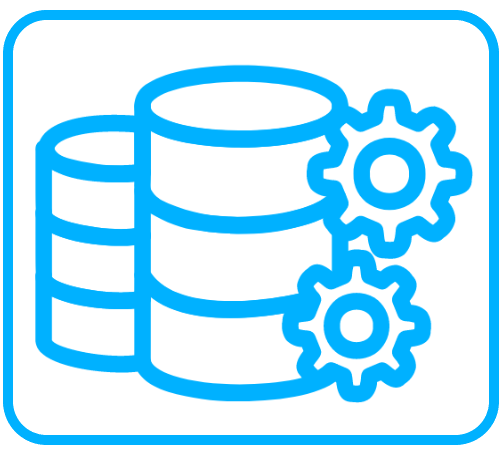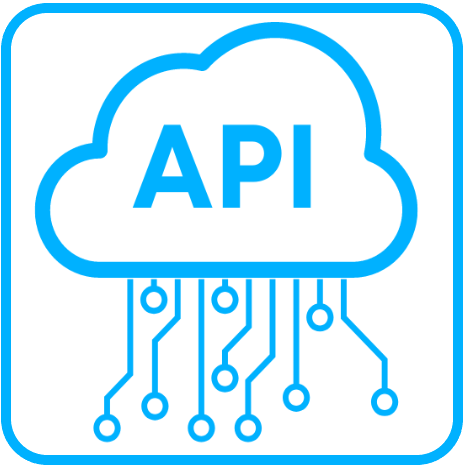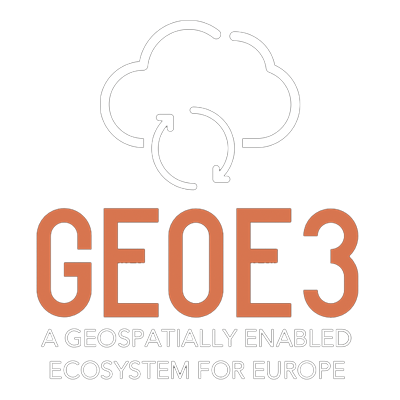Location Innovation Academy supports improving access, interoperability and integration of geospatial data and services, for free.
Click here to join the Location Innovation Academy.
The accessibility, interoperability, and integration of cross-border geospatial data and services have been accelerated in the GeoE3 project over the past two years. We are now offering the knowledge and ideas produced in the project to all interested parties by publishing the online training program called “Location Innovation Academy”.
Our learning materials offer a comprehensive set of modules that supports modern and cross-border management, integration, processing, and sharing of geospatial data. The content of the modules has been produced by an international team of experts from all over Europe.
This free and constantly evolving online training package includes three different courses, from which the learner can choose the modules to develop their skills.
Take a look at the introduction of each module below and log in the Academy!
For whom?
Location Innovation Academy is specifically targeted to national mapping agencies, meteorological institutions and other organizations producing geospatial data from different countries. However, in practice anyone can join the academy and start studying. You can start your studies by logging in to Moodle for free. You can study when it is best for yourself, regardless of place and time.
Some of the course contents are suitable for beginners, while some are more for experienced and technical experts who want to deepen their skills, for example, in the OGC API standards.
How to start learning?
We have made everything easy for you. To get started, you have to sign up to our platform:
- In the any page, click the “Log in” button on the upper-right corner. Click here to open Location Innovation Academy.
- If this is your first time, click “Create new account”. Only our introduction modules allow guest access.
- Fill out the registration form with your personal details. The username is used to log in to the academy.
- After submitting, check your email for a confirmation message from Moodle. Check also the spam folder!
- Follow the instructions in the email to activate your Moodle account.
- Once your account is activated, log in to Moodle using your username and password.
- Explore courses on the home page and open the most interesting one(s).
- As a default, you have to manually enroll yourself to the courses. Click “Enrol me” to access the course material.
- Start learning and remember to give feedback!
- If you have some questions, we are happy to answer via email: nhempelmann@ogc.org
You can explore the most interesting courses and modules wherever and whenever you want, or study them in the given orden. For some topics, we recommend to take modules in the given order due to cumulative information.
However, learning is easy and topics are very diverse. Check the modules below and also this page to find more information.
What courses are you interested in?
 Metadata, Semantic Enrichment and EDP
Metadata, Semantic Enrichment and EDP
Metadata is important for finding and using data over time and in different situations. In Europe, the standards and requirements for metadata often vary depending on where it’s published. For example, metadata published on the national level might need to be mapped and transformed to an alternative profile for publication in a European context. That’s why it’s important to make sure the metadata is complete and as extensive as possible to ensure its quality at the European level.
This module explains the importance of having good metadata and provides tools based on the principles of FAIR (Findability, Accessibility, Interoperability, and Reusability). That will help organizations create high-quality metadata that can be easily found and used in Europe and worldwide.
The module includes the following themes:
1. Metadata standards and profiles for geospatial data
● The first two modules provide an overview of the common standards and profiles required in the European context and explain how to do mappings between these standards and those used for search engine findability (e.g. schema.org). The modules also provide tools to implement these profiles and mappings and support you in ensuring that European Data Portal harvests your data sets correctly.
2. Semantic search
● The module will provide an overview of how to enrich your metadata profiles to include more specific metadata information that enables improved searchability of your datasets. This supports end users in finding your data sets and assessing their fit-for-use in each context.
3. Search engine findability
● Based on the mapping and profiles provided in the first module, the course will provide insight into how national metadata infrastructures can improve the findability of their datasets in a search engine such as Google. This section provides an architectural overview of the process of transforming and publishing metadata which is indexable by the search engine. All tools to fully implement this in your own context are also provided.
The module is produced by Laura Alemany Gómez from the Spatial Data Infrastructure of Spain (IDEE) and Lexi Rowland from The Netherlands’ Cadastre, Land Registry and Mapping Agency.
Click here to start learning
 Open Data and Licences
Open Data and Licences
As a data creator or provider, you need to understand the importance of proper licensing of geospatial data so that users can consult licensing conditions. This knowledge ensures that your data is used in a way that aligns with your goals and protects your rights as the creator.
In this module you will:
● get to know the basics of spatial data and open data
● learn the key principles of interoperability
● know what licenses are used for open spatial data and open-source software
● know where the spatial data is described in the metadata file
● know how to use the Joinup Licencing Assistant (JLA) to select and compare open licenses.
After learning this module, you will have a strong understanding of geospatial and open data, interoperability and licensing. That will benefit your organization in many ways. It improves the usability, availability and accessibility of data, and helps your organization comply with national and international laws and licensing policies.
The module is produced by Paloma Adab from the National Centre for Geographic Information (CNIG) of Spain.
Click here to start learning
 Data Quality Assurance
Data Quality Assurance
Data can be one of the most valuable assets for organizations in many ways. Despite that, not all organizations fully understand the importance of its quality. Even if they are aware of its impact, they may struggle with improving it.
The most effective way to guarantee high-quality data is through automation, as this can lead to cost efficiency, improved customer satisfaction, and new opportunities to reap the benefits of (geospatial) data. When data is shared or integrated across country borders or different systems, the quality must be known. This e-learning module will demonstrate how to achieve this.
In more detail, this module will help you to understand the basics of data quality, its impacts, and its improvement, especially in data integration processes. The module will comprehensively demonstrate the Data Quality Assurance (DQA) process, combining the essential theoretical background and concepts and the real-life example.
By incorporating DQA into daily data management routines, individuals and organizations can ensure that their geospatial data is of high quality and supports effective decision-making and planning. After this module, you can improve your data to be even more useful.
The module is produced by Alpo Turunen from the National Land Survey of Finland.
Click here to start learning
 Quality Dashboards
Quality Dashboards
Data and service quality are topics covered in ISO metadata, but these concepts can be difficult for non-experts in that specific field to grasp. Visualising this quality information and highlighting the relevant aspects in a use case will greatly help in communicating quality metrics to end users.
This module focuses on building data quality dashboards, equipping learners with the knowledge and skills to create intuitive and informative dashboards. These dashboards offer insights into the quality of data and services within a platform.
By studying this module, you will understand:
● Why data and service quality are important to visualize
● How to design and construct quality dashboards for spatial data and services.
● How to visualize data for your dashboard
● How to collect, process, and visualize relevant information
The module is written by Sampo Savolainen from Spatineo and Camille Cossec from the National Land Survey of Finland.
Click here to start learning
 Semantic and Organisational Interoperability
Semantic and Organisational Interoperability
Interoperability plays a vital role in our interconnected world, enabling organizations to collaborate towards mutually beneficial goals by seamlessly sharing information and knowledge. According to the European Interoperability Framework (EIF), interoperability is defined as the ability of organizations to interact through the exchange of data between their ICT systems, supporting their business processes and driving innovation.
In this module, we will explore the concept of interoperability, its various layers, and its significance within the context of spatial data infrastructure (SDI) and European initiatives. By understanding the principles and practices of interoperability, you will be better equipped to navigate the challenges and harness their immense potential.
Key learning objectives:
● Understand the European Interoperability Framework (EIF) definition of interoperability.
● Explore the requirements for achieving interoperability across data, metadata, and services.
● Gain insights into handling interoperability from both organizational and semantical perspectives.
● Recognize the critical importance of aligning business processes, responsibilities, and expectations among stakeholders within the ecosystem.
Throughout this module, we will illustrate these concepts with real-life examples of the GeoE3 project, highlighting the benefits and challenges faced in achieving interoperability. Are you ready to enhance your understanding of interoperability and its practical applications?
The module is written by Morten Borrebaek and Knut Jetlund from Kartverket Norway.
Click here to start learning.
 Service Management (4 modules)
Service Management (4 modules)
The geospatial world is changing and Open Geospatial Consortium’s Web Services (such as WFS, WMS, WMTS) are going down in history. They are based on 15 years old solutions, so the newer and more modern set of standards, OGC API standards is going to replace them soon. To keep up with the development, it is time for developers and data providers to update their knowledge and learn how OGC APIs work.
To do so, this course provides a comprehensive overview of the OGC API Standards and how they can be used to facilitate the interoperability of geospatial services. The course has four modules in total. It begins by introducing the basic principles and vocabulary of the standards and ends up showing real-life implementation examples and illustrative videos.
Therefore, the learning material is cumulative. We recommend exploring modules in the given order to fully understand everything but if you feel confident, feel free to dive into one module or study them all!
After this course, you know how to select the most relevant OGC API standard for your data and understand how to use and implement it. That helps you to combine different OGC APIs as building blocks of your data ecosystem.
The modules are written by Alpo Turunen from the National Land Survey of Finland and Nils Hempelmann from Open Geospatial Consortium.
Click here to start learning
 Joining spatial and statistical data
Joining spatial and statistical data
Combining location data with statistical information gives new insight into complex challenges from a local to European or global scale.
Authoritative statistical data from various data sources need to be pinpointed and combined with high-quality and reliable geographic location information. This enables decision-makers from local to global levels to comprehend more holistically fast-evolving and complex cross-domain and cross-border phenomena. Data integration requires solid institutional collaboration across governmental silos as well as organisation-level investments in capacity building and development of information systems and processes.
However, the technical foundation and principles of merging data are straightforward and easily understandable. Standardised solutions following common best practices provide cost-effective implementations fit-for-purpose to meet modern user demands and to help data providers to optimise their resource utilisation.
In this e-learning module, the reader is introduced to basic common characteristics of statistical and geospatial information required to successfully combine the data. In addition, the reader will get a practical demonstration of the data joining process and its outcome using a standard data joining service implementation and data examples from Statistics Finland and the National Land Survey of Finland. This module is highly recommended to experts and developers in statistical institutes and geospatial agencies.
The module is written by Pekka Latvala and Panu Muhli from the National Land Survey of Finland.
Click here to start learning
 Meteorological data integration
Meteorological data integration
Dynamic integration of climate attributes to geospatial features provides significant benefits, for example in spatial analysis aimed at the improved energy efficiency of built-up areas. Especially now, during the current European-wise energy crisis, it is imperative to provide extensive, easy-to-use harmonized access to climate information coming from different European countries. This would streamline the international efforts aimed at solving the energy crisis and would help the actors in the field to expand their operations internationally.
Unfortunately, there is still a great variation in the access mechanisms by which the meteorological agencies make their climate attributes available. To facilitate this challenge, this module helps to access climate from different meteorological data portals of different countries and integrate that into geospatial data.
Participants will learn about the collection of climate attributes, such as air temperature, windspeed, and yearly sunshine hours, and how they can be derived from meteorological data and integrated with geospatial objects, such as buildings. The module also covers the challenge of harmonizing access to climate information across European countries, including different access mechanisms, portal standards, and authentication requirements.
Using Python scripting, participants will learn how to access meteorological portals and retrieve climate attributes for various European countries. The fine-grained API approach is explained with the Finnish and Norwegian meteorological portals and the file download approach with the Dutch and Spanish portals. The module is recommended for application developers needing access to climate attributes in various European countries.
The module is written by Mikko Visa from Finnish Meteorological Institute and Lassi Lehto from the National Land Survey of Finland.
Click here to start learning
 Applications for OGC APIs
Applications for OGC APIs
Open Geospatial Consortium (OGC) is modernizing its API specifications to better align with current technology and design patterns such as REST, JSON and OpenAPI. That improves interoperability, reduces development time and speeds up integration processes within the member states of the European Union, for example. To keep up with the development, it is time for developers and data providers to update their knowledge and learn how OGC APIs work.
This module demonstrates how to implement OGC API Features using different commonly used clients and services with practical examples and recommendations. For example, the module covers OGC APIs in QGIS and with GeoServer. Also, the service metadata is discussed and demonstrated.
The module assumes that you are somewhat familiar with OGC APIs, so if you are not, please check the course “Service Management” before exploring the current module.
Using and deploying the OGC APIs is simple and versatile – let it work to your benefit.
The module is written by Triin Tajur, Andres Kasekamp and Hanno Kuus from the Maa-amet Estonian Land Board.
Click here to start learning
Give us feedback and provide more content!
We welcome feedback on modules. Feedback can be left directly at Moodle or contact OGC (innovation@ogc.org). We will monitor with interest what kind of feedback we receive from different user groups and improve materials based on the feedback received.
Location Innovation Academy’s maintenance responsibilities as well as further development management are done by OGC and Location Innovation Hub. If any other project or organization is interested in producing a learning module as part of the Location Innovation Academy, we are happy to provide our platform for that.

